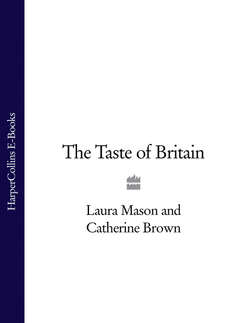Читать книгу The Taste of Britain - Hugh Fearnley-Whittingstall - Страница 175
TECHNIQUE:
ОглавлениеCiders vary between makers and harvests, as do wines. Methods of production are at heart identical; it is variations in soils, micro-climate and fruit varieties which most affect the flavour. As yet, little systematic attempt to classify these has been made in respect of cider, and the necessary vocabulary is underdeveloped in English.
The hallowed routine followed for making farmhouse cider began with the harvest. The apples were either allowed to fall naturally or were shaken off the tree with a long pole; then they were taken into an apple loft and allowed to mellow. The stored apples of different varieties were blended. They were crushed in a horse-driven stone wheel-mill or, at the end of the nineteenth century, in a powered rotary press. Sometimes the crushed apple pulp (pomace) was left to stand to allow flavour to develop. It would then be pressed. It was placed in 4-6cm layers on hairs, or thick horsehair cloths which were folded over to envelop the pulp, and then built up into a cheese consisting of about 10 filled cloths. Pressure was applied from above by screwing a plate down on to the cheese. In Devon and Dorset, barley straw was used in place of the hairs, but this is no longer practised. As the juice flowed from the press, it was poured into barrels, loosely stoppered, and left to work under the action of naturally present yeasts. Once fermentation had ceased, the cider was racked off the spent yeast.
Modern production follows the same sequence but with refinements. The fruit may be dislodged and harvested mechanically. It is blended, picked over and cleaned before mechanical crushing. Hydraulically operated presses, with layers of fruit packed in polypropylene cloths, similar to the old-fashioned screw presses, are used to extract juice by small producers; big horizontal or continuous presses are used for factory operations. The juice may be sterilized with sulphur dioxide and yeast cultures added. Other additions are sugar if the year has been poor, and water by some makers. Fermentation takes place in large vats. The result is generally still, strong and dry. If sweet is required it is usually obtained by adding sugar. Royal cider, where fermentation is stopped by the addition of strong alcohol - which will give a sweeter finish - is not pursued as it used to be in the classic period. Some cider apples have sufficiently well-balanced acid and tannin to produce good cider without further blending. A few makers offer cider produced from single varieties. Otherwise, the apples may be blended before milling or after fermentation. Large companies have turned cider-making into a year-round activity by holding part of the year’s apple juice in a concentrated form until required; they may also use concentrated apple juice from abroad.
